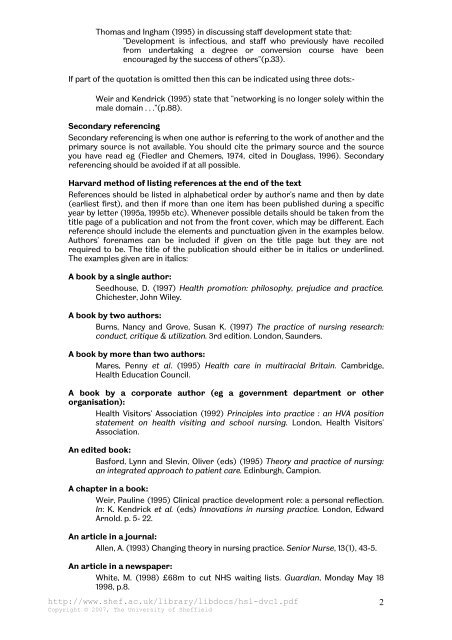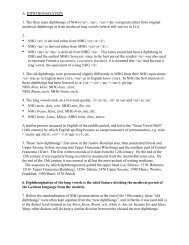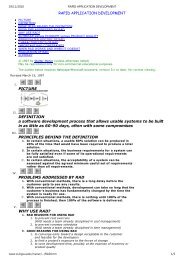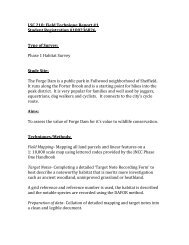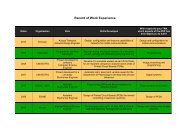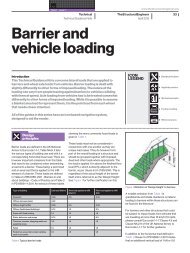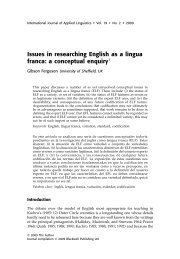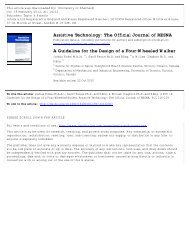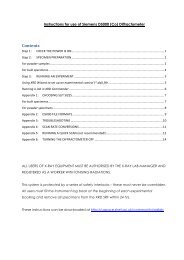Harvard referencing guide HSL-DVC1 - University of Sheffield
Harvard referencing guide HSL-DVC1 - University of Sheffield
Harvard referencing guide HSL-DVC1 - University of Sheffield
You also want an ePaper? Increase the reach of your titles
YUMPU automatically turns print PDFs into web optimized ePapers that Google loves.
Thomas and Ingham (1995) in discussing staff development state that:<br />
"Development is infectious, and staff who previously have recoiled<br />
from undertaking a degree or conversion course have been<br />
encouraged by the success <strong>of</strong> others"(p.33).<br />
If part <strong>of</strong> the quotation is omitted then this can be indicated using three dots:-<br />
Weir and Kendrick (1995) state that "networking is no longer solely within the<br />
male domain . . ."(p.88).<br />
Secondary <strong>referencing</strong><br />
Secondary <strong>referencing</strong> is when one author is referring to the work <strong>of</strong> another and the<br />
primary source is not available. You should cite the primary source and the source<br />
you have read eg (Fiedler and Chemers, 1974, cited in Douglass, 1996). Secondary<br />
<strong>referencing</strong> should be avoided if at all possible.<br />
<strong>Harvard</strong> method <strong>of</strong> listing references at the end <strong>of</strong> the text<br />
References should be listed in alphabetical order by author's name and then by date<br />
(earliest first), and then if more than one item has been published during a specific<br />
year by letter (1995a, 1995b etc). Whenever possible details should be taken from the<br />
title page <strong>of</strong> a publication and not from the front cover, which may be different. Each<br />
reference should include the elements and punctuation given in the examples below.<br />
Authors' forenames can be included if given on the title page but they are not<br />
required to be. The title <strong>of</strong> the publication should either be in italics or underlined.<br />
The examples given are in italics:<br />
A book by a single author:<br />
Seedhouse, D. (1997) Health promotion: philosophy, prejudice and practice.<br />
Chichester, John Wiley.<br />
A book by two authors:<br />
Burns, Nancy and Grove, Susan K. (1997) The practice <strong>of</strong> nursing research:<br />
conduct, critique & utilization. 3rd edition. London, Saunders.<br />
A book by more than two authors:<br />
Mares, Penny et al. (1995) Health care in multiracial Britain. Cambridge,<br />
Health Education Council.<br />
A book by a corporate author (eg a government department or other<br />
organisation):<br />
Health Visitors' Association (1992) Principles into practice : an HVA position<br />
statement on health visiting and school nursing. London, Health Visitors'<br />
Association.<br />
An edited book:<br />
Basford, Lynn and Slevin, Oliver (eds) (1995) Theory and practice <strong>of</strong> nursing:<br />
an integrated approach to patient care. Edinburgh, Campion.<br />
A chapter in a book:<br />
Weir, Pauline (1995) Clinical practice development role: a personal reflection.<br />
In: K. Kendrick et al. (eds) Innovations in nursing practice. London, Edward<br />
Arnold. p. 5- 22.<br />
An article in a journal:<br />
Allen, A. (1993) Changing theory in nursing practice. Senior Nurse, 13(1), 43-5.<br />
An article in a newspaper:<br />
White, M. (1998) £68m to cut NHS waiting lists. Guardian, Monday May 18<br />
1998, p.8.<br />
http://www.shef.ac.uk/library/libdocs/hsl-dvc1.pdf<br />
Copyright © 2007, The <strong>University</strong> <strong>of</strong> <strong>Sheffield</strong><br />
2


